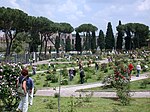Circus Maximus
Ancient Roman buildings and structures in RomeAncient Roman circuses in RomeRoman archaeologyRome R. XII Ripa

The Circus Maximus (Latin for "largest circus"; Italian: Circo Massimo) is an ancient Roman chariot-racing stadium and mass entertainment venue in Rome, Italy. In the valley between the Aventine and Palatine hills, it was the first and largest stadium in ancient Rome and its later Empire. It measured 621 m (2,037 ft) in length and 118 m (387 ft) in width and could accommodate over 150,000 spectators. In its fully developed form, it became the model for circuses throughout the Roman Empire. The site is now a public park.
Excerpt from the Wikipedia article Circus Maximus (License: CC BY-SA 3.0, Authors, Images).Circus Maximus
Via del Circo Massimo, Rome Municipio Roma I
Geographical coordinates (GPS) Address External links Nearby Places Show on map
Geographical coordinates (GPS)
| Latitude | Longitude |
|---|---|
| N 41.8859 ° | E 12.4857 ° |
Address
Circo Massimo
Via del Circo Massimo
00153 Rome, Municipio Roma I
Lazio, Italy
Open on Google Maps








